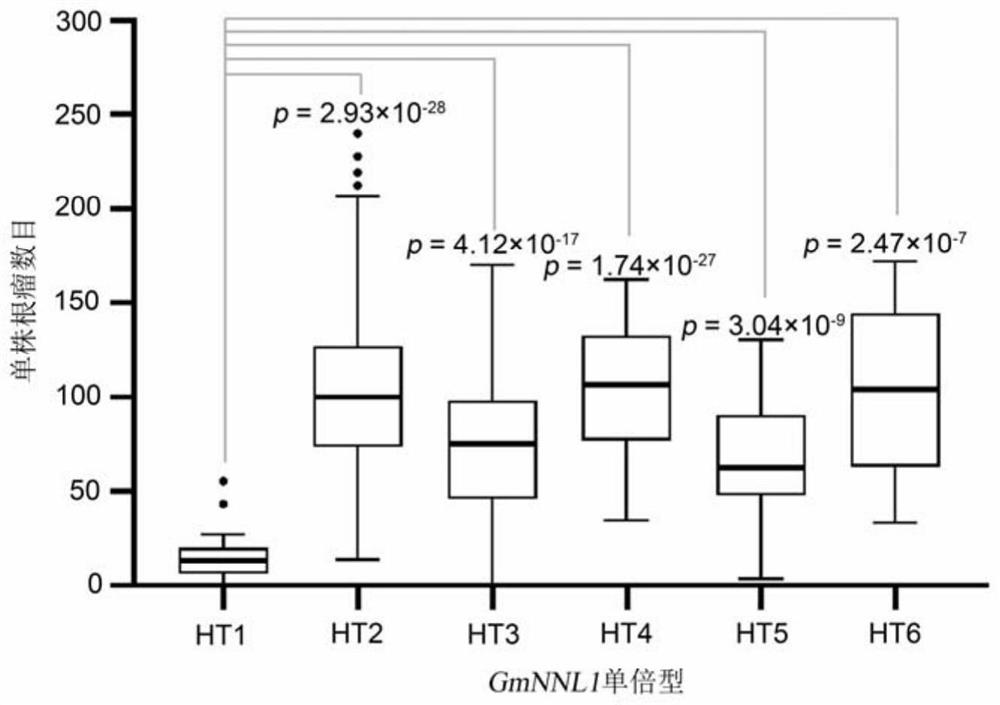An r gene that controls soybean-rhizobia compatibility and its protein and application
A rhizobia and matching technology, applied in the fields of application, genetic engineering, plant genetic improvement, etc., to achieve the effect of improving the ability of symbiotic nitrogen fixation
- Summary
- Abstract
- Description
- Claims
- Application Information
AI Technical Summary
Problems solved by technology
Method used
Image
Examples
Embodiment 1
[0027] In this application, the core germplasm of cultivated soybean is constructed. Through genome-wide association analysis, an R gene in soybean, GmNNL1, that can simultaneously affect the number of soybean nodules, nitrogenase activity per plant and above-ground biomass is identified. Through haplotype analysis, it was found that among the 6 main haplotypes of GmNNL1, only GmNNL1 HT1 (sequence shown in SEQ ID No. 2) can normally encode a complete typical R protein of TIR-NBS-LRR, and the other 5 haplotypes (sequences shown in SEQ ID NO.4, SEQ ID NO.5, SEQ ID NO.6, SEQ ID NO.7 or SEQ ID NO.8) all resulted in incomplete protein forms due to the insertion of a transposon GmSINE1 or the deletion of a single base ( figure 1 ). Through haplotype analysis, it was found that GmNNL1 HT1 The number of nodules of haplotype soybean was significantly lower than that of other haplotypes ( figure 2 ), by comparing the structurally intact form of the R protein GmNNL1 HT1 and the inco...
Embodiment 2
[0032] The gene sequence of GmNNL1 was obtained using the following method:
[0033] The total volume of the reaction system was 50 μl, and the template was 1 μL (about 50 ng) of genomic DNA of soybean strain Hengfeng udon, 5 μl of 10×KOD enzyme reaction buffer, and 25 mM MgCL 2 2μl, 5mM dNTP 5μl, 5uM primer 5μl (primers NNL1-F and NNL1-R, each primer is 2.5μl), 1μl KOD enzyme, add ddH 2 O (sterile deionized water) to 50 μl. The reaction program was: denaturation at 94°C for 5 min, 94°C for 30 s, 55°C for 1 min, 68°C for 3.5 min for 35 cycles, and extension at 68°C for 10 min. The primers are: NNL1-F: ATGGCACACAGAACAGCACCATCT; NNL1-R: TCATTTAACAACATAGTACAAAC; finally a gene sequence containing the nucleotides described in SEQ ID NO.2 is obtained, and the protein encoded by the gene is shown in SEQ ID NO.3.
[0034] The protection content of the present invention also includes the nucleotide sequence corresponding to the amino acid sequence shown in SEQ ID NO. 3, and also in...
Embodiment 3
[0036] The application of GmNNL1 gene in regulating soybean-rhizobia compatibility and thus affecting the nitrogen fixation efficiency of soybean symbiosis. The application process is as follows:
[0037] The promoter and full-length CDS of GmNNL1 cloned from HFWD were cloned into pUB-GFP and transformed into Williams82 (WS82, GmNNL1 HT2 ), after inoculation with USDA110 in the obtained transgenic lines, GmNNL1 HT1 The higher the expression level, the less the number of nodules ( Image 6 ). Therefore, the nodulation of specific species of rhizobia can be reduced by this method. The specific process is:
[0038] (1) The GmNNL1 promoter region is obtained by the following methods:
[0039] The total volume of the reaction system is 50 μl, and the template is 1 μl (about 50 ng) of Hengfeng udon genomic DNA, 5 μl of 1×KOD enzyme reaction buffer, and 25 mM MgCL 2 2μl, 5μl of 5mM dNTP, 5μl of 5uM primer (2.5μl of primers pNNL1-F and pNNL1-R respectively), 1μl of KOD enzyme, a...
PUM
 Login to View More
Login to View More Abstract
Description
Claims
Application Information
 Login to View More
Login to View More - R&D
- Intellectual Property
- Life Sciences
- Materials
- Tech Scout
- Unparalleled Data Quality
- Higher Quality Content
- 60% Fewer Hallucinations
Browse by: Latest US Patents, China's latest patents, Technical Efficacy Thesaurus, Application Domain, Technology Topic, Popular Technical Reports.
© 2025 PatSnap. All rights reserved.Legal|Privacy policy|Modern Slavery Act Transparency Statement|Sitemap|About US| Contact US: help@patsnap.com



